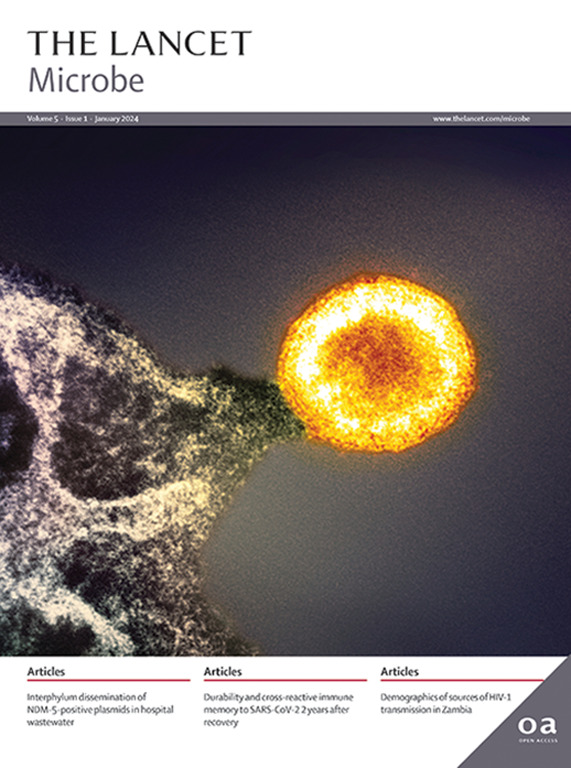巴拿马肠沙门氏菌血清型的全球多样性和进化:基因组流行病学研究。
IF 20.4
1区 生物学
Q1 INFECTIOUS DISEASES
引用次数: 0
摘要
背景:非伤寒沙门氏菌是一种全球重要的细菌性病原体,通常与食源性胃肠道感染有关。一些非伤寒沙门氏菌血清型也可以在人体内典型的无菌部位定植,引起侵袭性非伤寒沙门氏菌病。巴拿马肠沙门氏菌血清型是造成大量人类血液感染病例的原因,但尽管其在全球传播,多次暴发,并报道与侵袭性非伤寒沙门氏菌病有关,但巴拿马肠沙门氏菌血清型(S Panama)尚未得到充分研究。我们的目的是描述巴拿马S的基因组流行病学和进化历史,为了解这一全球重要的血清型提供重要的基线。方法:在这项基因组流行病学研究中,我们分析了来自1931-2019年历史收集、国家监测数据集以及公开的流行病学和全基因组测序数据的巴拿马S基因组。使用最大似然和贝叶斯系统动力学方法研究种群结构和进化历史,并推断时空传播。将不同的生物信息学方法与短读和长读数据相结合,用于表征抗菌素耐药性(AMR)和侵袭性遗传标记的地理和进化支特异性趋势。研究结果:我们分析了836个S巴拿马基因组,其中559个(67%)测序作为本研究的一部分。该藏品代表了所有有人居住的大陆,包括1931年至2019年收集的隔离株。我们确定了四个地理上相连的S巴拿马分支的存在(C1,即拉丁美洲和加勒比分支;n=338], C2[即欧洲进化支;n=124], C3[即马提尼克分支;n=131]和C4[即亚洲和大洋洲分支];n=104])和AMR剖面的区域趋势。大多数分离株(836株中的715株[86%])对抗生素泛敏感,属于在拉丁美洲和加勒比流行的分支(64%,n=458)。我们收集的大多数耐药菌株(121株中的113株[93%])属于C4枝(即亚洲和大洋洲枝)和C2枝(即欧洲枝),后者具有最高的入侵指数值(基于196个肠外预测基因的保守性)。解释:这是首次对巴拿马藜进行大规模系统发育分析,揭示了所鉴定基因组亚型的种群结构、抗菌素耐药性、全球生态和入侵性遗传标记的重要信息。我们的发现为了解巴拿马S感染提供了重要的基础。应通过持续监测监测侵袭指数值升高的多药耐药分支的存在,因为此类分支可能会增加公共卫生风险。资助:联合王国研究与创新全球挑战研究基金和生物技术与生物科学研究理事会、联合王国医学研究理事会、威康信托基金、约翰·列侬纪念奖学金、巴斯德研究所、法国圣德公共学院、洛奇-莱斯燧发枪手基金会、avenir投资方案以及澳大利亚国家卫生和医学研究理事会。本文章由计算机程序翻译,如有差异,请以英文原文为准。
Global diversity and evolution of Salmonella enterica serovar Panama: a genomic epidemiology study
Background
Non-typhoidal Salmonella is a globally important bacterial pathogen, typically associated with foodborne gastrointestinal infection. Some non-typhoidal Salmonella serovars can also colonise typically sterile sites in people to cause invasive non-typhoidal Salmonella disease. Salmonella enterica serovar Panama is responsible for a substantial number of cases of human bloodstream infection, but despite its global dissemination, numerous outbreaks, and a reported association with invasive non-typhoidal Salmonella disease, S enterica serovar Panama (S Panama) is understudied. We aimed to describe the genomic epidemiology and evolutionary history of S Panama to provide a vital baseline of understanding for this globally important serovar.
Methods
In this genomic epidemiology study, we analysed S Panama genomes derived from historical collections, national surveillance datasets, and publicly available epidemiological and whole-genome sequencing data which span the years 1931–2019. Maximum likelihood and Bayesian phylodynamic approaches were used to investigate population structure and evolutionary history and to infer geotemporal dissemination. A combination of different bioinformatic approaches with short-read and long-read data were used to characterise geographical and clade-specific trends in antimicrobial resistance (AMR) and genetic markers for invasiveness.
Findings
We analysed 836 S Panama genomes, of which 559 (67%) were sequenced as part of this study. The collection represents all inhabited continents and includes isolates collected between 1931 and 2019. We identified the presence of four geographically linked S Panama clades (C1 [ie, the Latin America and the Caribbean clade; n=338], C2 [ie, the European clade; n=124], C3 [ie, the Martinique clade; n=131], and C4 [ie, the Asia and Oceania clade; n=104]) and regional trends in AMR profiles. Most isolates (715 [86%] of 836) were pan-susceptible to antibiotics and belonged to clades circulating in Latin America and the Caribbean (64%, n=458). Most antibiotic-resistant isolates in our collection (113 [93%] of 121) fell within clades C4 (ie, the Asia and Oceania clade) and C2 (ie, the European clade), the latter of which had the highest invasiveness index values based on the conservation of 196 extraintestinal predictor genes.
Interpretation
This first large-scale phylogenetic analysis of S Panama has revealed important information about the population structure, AMR, global ecology, and genetic markers of invasiveness of the identified genomic subtypes. Our findings provide an important baseline for understanding S Panama infection. The presence of multidrug-resistant clades with elevated invasiveness index values should be monitored through ongoing surveillance, as such clades could pose an increased public health risk.
Funding
UK Research and Innovation Global Challenges Research Fund and Biotechnology and Biological Sciences Research Council, UK Medical Research Council, Wellcome Trust, John Lennon Memorial Scholarship, Institut Pasteur, Santé publique France, Fondation Le Roch-Les Mousquetaires, Investissement d’Avenir Programme, and Australian National Health and Medical Research Council.
求助全文
通过发布文献求助,成功后即可免费获取论文全文。
去求助
来源期刊

Lancet Microbe
Multiple-
CiteScore
27.20
自引率
0.80%
发文量
278
审稿时长
6 weeks
期刊介绍:
The Lancet Microbe is a gold open access journal committed to publishing content relevant to clinical microbiologists worldwide, with a focus on studies that advance clinical understanding, challenge the status quo, and advocate change in health policy.
 求助内容:
求助内容: 应助结果提醒方式:
应助结果提醒方式:


